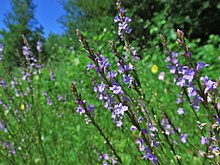| Verbena halei | |
|---|---|

| |
| Scientific classification | |
| Kingdom: | Plantae |
| Clade: | Tracheophytes |
| Clade: | Angiosperms |
| Clade: | Eudicots |
| Clade: | Asterids |
| Order: | Lamiales |
| Family: | Verbenaceae |
| Genus: | Verbena |
| Species: | V. halei
|
| Binomial name | |
| Verbena halei | |
| Synonyms[1] | |
| |
Verbena halei, commonly known as Texas vervain, Texas verbena, or slender verbena, is a flowering plant in the vervain family, Verbenaceae.[2][3] It is native to much of the southern United States and Mexico. Scattered populations have been found along the east coast (North Carolina), and its range stretches south to Florida, west to Arizona, and throughout most of Mexico.[1][2][4] It is a perennial shrub and grows in thickets and woodland borders. Flowers bloom March to June.[5] It has been introduced to Australia, in Queensland, New South Wales, Victoria, and South Australia.[1][6]
It was first formally named by American botanist John Kunkel Small in 1898.[7] It is sometimes considered a subspecies or variety of Verbena officinalis.[6]
References[edit]
- ^ a b c "Verbena halei Small". Plants of the World Online. Royal Botanic Gardens, Kew. Retrieved 5 January 2020.
- ^ a b "Plants Profile for Verbena halei (Texas vervain)". plants.usda.gov. Retrieved 2020-01-05.
- ^ "Verbena halei". Integrated Taxonomic Information System. Retrieved 5 January 2020.
- ^ "Name - Verbena halei Small". www.tropicos.org. Retrieved 2020-01-05.
- ^ "Lady Bird Johnson Wildflower Center - The University of Texas at Austin". www.wildflower.org. Retrieved 2022-05-07.
- ^ a b Munir, Ahmad Abid (2002). "A taxonomic revision of the genus Verbena L. (Verbenaceae) in Australia". Journal of the Adelaide Botanic Garden. 20: 21–103. ISSN 0313-4083. JSTOR 23874130.
- ^ "Verbena halei Small". ipni.org. International Plant Names Index. Retrieved 5 January 2020.